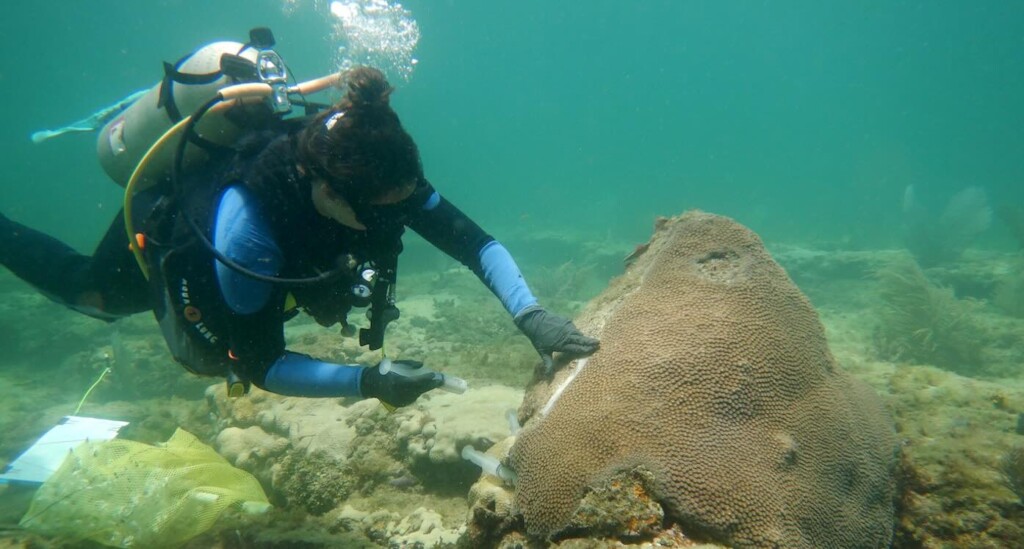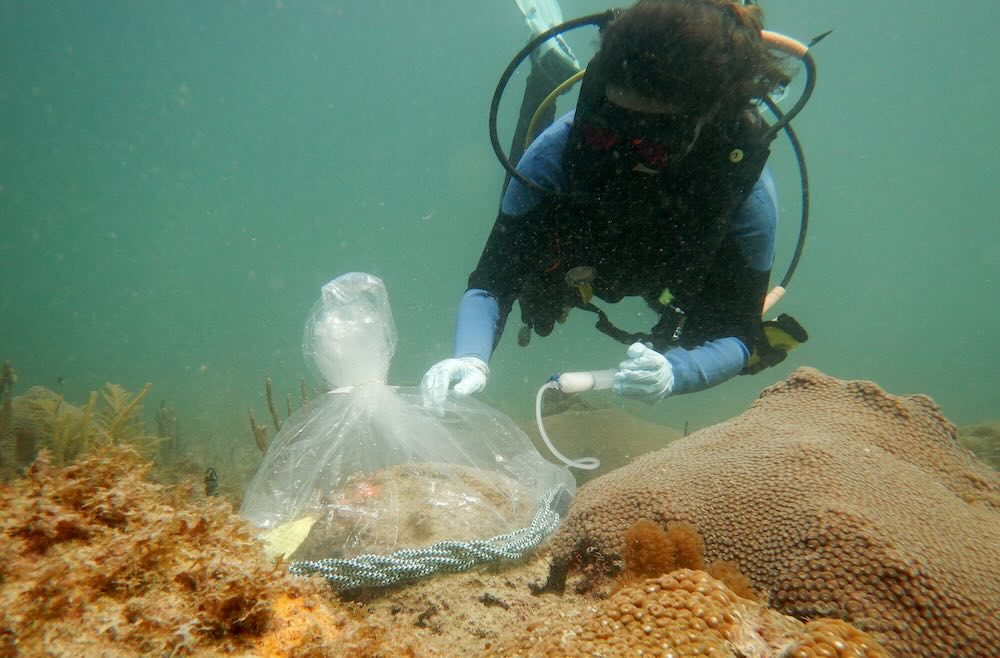 Diver treats diseased coral – Credit: Hunter Noren for Smithsonian / SWNS
Diver treats diseased coral – Credit: Hunter Noren for Smithsonian / SWNSA new study from researchers at Smithsonian’s National Museum of Natural History demonstrated how a probiotic could save the Caribbean’s at-risk coral.
The compound slowed the spread of a deadly disease which began damaging coral in Florida in 2014 and has since rapidly spread south, throughout the Caribbean.
The study documents 6 years of testing in the lab and off the coast of Florida, to identified the best available treatment to combat ‘stony coral tissue loss disease (SCTLD).
Probiotics, like those in yogurt, are live bacteria and yeasts that provide various health benefits for the human microbiome in the gut.
Published in the journal Frontiers in Marine Science, the findings revealed that applying the bacterial probiotic treatment to a coral colony helped prevent tissue loss and slow the spread of SCTLD in already infected wild corals in Florida.
They say the new treatment provides a viable alternative to the current method of applying an antibiotic, which only offers temporary protection and also runs the risk of creating resistant strains of SCTLD.
“The goal of using the probiotics is to get the corals to take up this beneficial bacterium and incorporate it into their natural microbiome, said study co-leader Dr. Valerie Paul, head scientist at the Smithsonian Marine Station at Fort Pierce, Florida. “The probiotics then will provide a more lasting protection.”
Unlike other disease-causing organisms, which usually target specific species, SCTLD infects more than 30 different types of stony corals, including boulder-shaped brain corals and limb-like pillar corals. As it spreads, the disease causes the corals’ soft tissue to slough off, leaving behind white patches of exposed skeleton.
Scientists have yet to identify the exact cause of SCTLD, which can devastate an entire coral colony in just weeks, but it appears to be linked to harmful bacteria.
Dr. Paul and her colleagues have spent six years investigating whether probiotics could combat the disease because, like humans, corals host communities known as microbiomes that are bustling with bacteria. Some of those tiny organisms, found in both coral tissue and the protective mucus that corals secrete, produce antioxidants and vitamins to keep their coral hosts healthy.
MORE COOL CORAL NEWS:
• Coral Reef Production is Boosted by 20 Times With Special Ink From Pink Algae That Attracts Colonies
• Full Recovery for Coral Reef Within 4 Years – The Speed of Restoration They Saw was ‘Incredible’
The researchers first studied the microbiomes of corals that were impervious to the SCTLD so they could harvest probiotics from the disease-resistant species and use them to strengthen the microbiomes of susceptible corals.
The team then tested more than 200 strains of bacteria from the disease-resistant corals, and settled on the probiotic ‘Pseudoalteromonas sp. McH1-7’ from the great star coral, which produces several different antibacterial compounds, as the “ideal candidate” to combat SCTLD.
They initially tested McH1-7 in the lab on live coral and discovered that the probiotic reliably prevented the spread of SCTLD. So, in 2020, they conducted field tests on a shallow reef near Fort Lauderdale where colonies were infected with the disease.
 Diver treats diseased coral – Credit: Hunter Noren for Smithsonian / SWNS
Diver treats diseased coral – Credit: Hunter Noren for Smithsonian / SWNSThe coral was treated with a solution of seawater containing McH1-7 inside weighted plastic bags where the probiotics were administered, covering each colony.
“This created a little mini-aquarium that kept the probiotics around each coral colony.”
The team found after more than two years of monitoring the colony that the probiotic successfully slowed the spread of SCTLD—and the samples revealed that the probiotic was effective without dominating the corals’ natural microbes.
To date, the most common treatment for SCTLD was applying paste that contains the antibiotic amoxicillin to the diseased coral. But while the balm can effectively stem disease spread, it is temporarily, and needs to be frequently reapplied to the corals’ lesions, which not only takes time and resources, but also increases the risk that the microbes causing SCTLD could develop resistance to amoxicillin and other antibiotics.
RELATED: Multivitamins Could Help Save the Coral Reefs, New Research Shows
“Antibiotics do not stop future outbreaks,” said Dr Paul. “The disease can quickly come back, even on the same coral colonies that have been treated.”
Caribbean bound
While the probiotic proved to be an effective treatment among Florida’s northern reefs, the team needs to calibrate the treatment for other regions—because when they conducted similar tests on reefs in the Florida Keys (much further south), results were mixed, probably due to regional differences in the disease itself.
WOW! Broadcasting Audio of Healthy Reef Sounds Can Spur Degraded Coral to New Life
But Dr. Paul is confident that probiotics could become a “crucial” tool for combatting SCTLD across the Caribbean.
“Corals are naturally rich with bacteria and it’s not surprising that the bacterial composition is important for their health.
“We’re trying to figure out which bacteria can make these vibrant microbiomes even stronger.”
HELP OCEAN-LOVING FRIENDS TAKE A DEEP DIVE–Share the News on Social Media…
Source link

